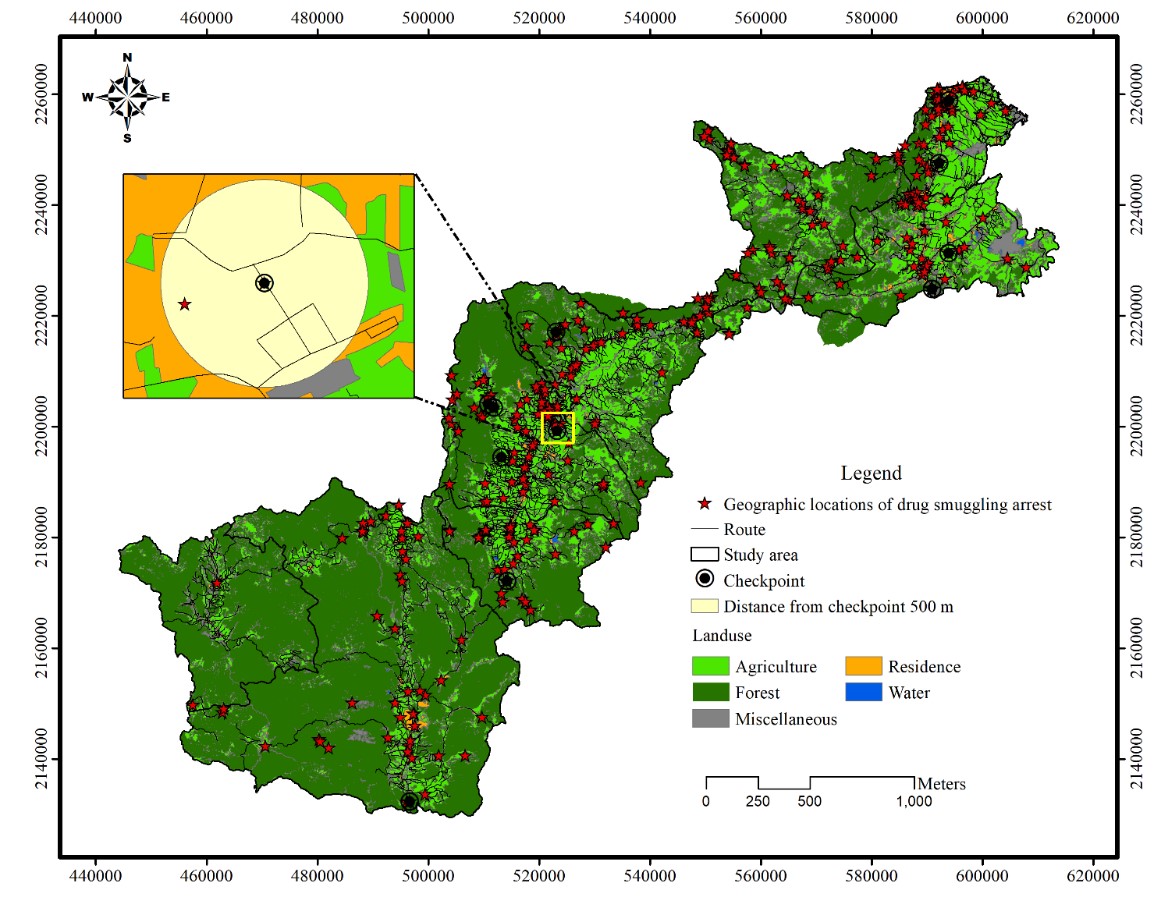Spatial Relationship of Drug Smuggling in Northern Thailand Using GIS-based Knowledge Discovery DOI: 10.32526/ennrj.18.3.2020.26
Main Article Content
Abstract
The number of drug users has been growing, likely caused by oppressive social conditions. The drug situation in Thailand has changed so that it is no longer a production source. However, Thailand is one of the transit sites for narcotics smuggling. Drug smuggling occurs most recurrently along the border of Northern Thailand by topographic roads. Chiang Mai and Chiang Rai Provinces have been shown to have the highest statistics in terms of drug trafficking. In this investigation, eight districts adjacent to neighboring countries were chosen as the areas of study. These areas are Mae Chan, Mae Fa Luang, and Mae Sai located in Chiang Rai Province, as well as Fang, Chiang Dao, Mae Ai, Chai Prakan, and Wiang Haeng situated in Chiang Mai Province. This research studied the spatial relationship of factors related to narcotic smuggling using a data mining-based decision tree technique. The geographic locations of drug trafficking arrests were transferred into a data-mining process in order to assess the spatial relationships among types of exhibited drugs, season, land use, distance from checkpoint and smuggling routes. Drug smuggling risk areas were further predicted using decision tree modeling. The results revealed that the geographic locations of drug trafficking arrests in Mae Chan, Mae Sai, Mae Ai, and Fang Districts were related to the season factor. The distance from checkpoint showed a spatial relationship with drug smuggling arrests in the Chai Prakan District. Narcotic trafficking arrests in Mae Fa Luang were mostly related to land use and type of drug exhibited. Geo-locations of drug smuggling illustrated an independent relationship with smuggling routes. The results retrieved from the prediction-based decision tree method indicated that Chai Prakan, Mae Chan, Mae Sai, Mae Fa Luang, Mae Ai, Fang, Wiang Haeng and Chiang Dao Districts were high-risk drug smuggling areas. The precision value of prediction was found to be 0.652. These results could support spatial decision making for national drug smuggling monitoring and surveillance.
Article Details
Published articles are under the copyright of the Environment and Natural Resources Journal effective when the article is accepted for publication thus granting Environment and Natural Resources Journal all rights for the work so that both parties may be protected from the consequences of unauthorized use. Partially or totally publication of an article elsewhere is possible only after the consent from the editors.
References
2. Fayyad U, Piatetsky-Shapiro G, Smyth P. From data mining to knowledge discovery: An overview. In: Fayyad U, Piatetsky-Shapiro G, Smyth P, Ulthurusamy R, editors. Advances in Knowledge Discovery and Data Mining. Cambridge, United States: MIT Press; 1996. p. 1-34.
3. Fernández-Arteaga V, Tovilla-Zárate CA, Fresán A, González-Castro TB, Juárez-Rojop IE, López-Narváez L. Association between completed suicide and environmental temperature in a Mexican population, using the Knowledge Discovery in Database approach. Computer Methods and Programs in Biomedicine 2016;135:219-24.
4. Ge Q, Xiong F, Xie L, Chen J, Yu M. Dynamic interaction of soil-structure cluster. Soil Dynamics and Earthquake Engineering 2019;123:16-30.
5. Hand D, Mannila H, Smyth P. Principles of Data Mining. Cambridge, United States: MIT Press; 2001.
6. Harvey JM, Jiawei H. Geographic Data Mining and Knowledge Discovery. Boca Raton, United States: Taylor and Francis Group; 2009.
7. Kesavaraj G, Sukumaran S. A study on classification techniques in data mining. Proceedings of the Fourth International Conference on Computing, Communications and Networking Technologies (ICCCNT); 2013 Jul 4-6; Tiruchengode: India; 2013.
8. Kotu V, Deshpande B. Predictive Analytics and Data Mining: Concepts and Practice with Rapidminer. Waltham, United States: Elsevier; 2015.
9. Medel M, Lu Y, Chow E. Mexico's drug networks: Modeling the smuggling routes towards the United States. Applied Geography 2015;60:240-7.
10. Nguyen PM, Haghverdi A, Pue J, Botula YD, Le KV, Waegeman W. Comparison of statistical regression and data-mining techniques in estimating soil water retention of tropical delta soils. Biosystems Engineering 2017;153:12-27.
11. Office of the Narcotics Control Board. Drug situation in the northern region January 2017 [Internet]. 2017 [cited 2018 Aug 6]. Available from: https://www.oncb.go.th.
12. Oliveira MM, Camanho AS, Walden JB, Miguéis VL, Ferreira NB, Gaspar MB. Forecasting bivalve landings with multiple regression and data mining techniques: The case of the Portuguese artisanal dredge fleet. Marine Policy 2017;84:110-8.
13. Ours JV, Williams J. The effects of cannabis use on physical and mental health. Journal of Health Economics 2012;31:564-77.
14. Peter H, Hasan I, Kasantikul R, Lawpoolsri S, Sa-angchai P, Kaewkungwal J. Spatiotemporal bayesian networks for malaria prediction. Journal of Artificial Intelligence in Medicine 2018;84:127-38.
15. Robert O, Kumsap C, Janpengpen A. Simulation of counter drugs operations based on geospatial technology for use in a military training simulator. International Journal of Simulation and Process Modeling 2018;13:402-15.
16. The Bureau of Registration Administration. Official statistics registration systems [Internet]. 2019 [cited 2020 Feb 26]. Available from: http://stat.bora.dopa.go.th.
17. Thomas MC, Zhu W, Romagnoli JA. Data mining and clustering in chemical process databases for monitoring and knowledge discovery. Journal of Process Control 2018;67:160-75.
18. United Nations Office on Drugs and Crime. World drug report 2018 [Internet]. 2018 [cited 2019 Jun 16]. Available from: https://www.unodc.org/wdr2018.
19. United Nations Office on Drugs and Crime. The social impact of drug abuse [Internet]. 1995 [cited 2019 Oct 13]. Available from: https://www.unodc.org/pdf/technical_series_1995-03-01_1.pdf.
20. Wong JY, Chung PH. Managing valuable Taiwanese airline passengers using knowledge discovery in database techniques. Journal of Air Transport Management 2007;13:362-70.
21. Xu C, Bao J, Wang C, Liu P. Association rule analysis of factors contributing to extraordinarily severe traffic crashes in China. Journal of Safety Research 2018;67:65-75.
22. Zhao Y, Li Y, Zhang L, Wang Q. Groundwater level prediction of landslide based on classification and regression tree. Geodesy and Geodynamics 2016;7:348-55.

